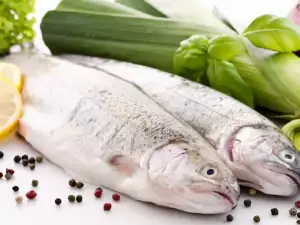There is no place in nature more rhythmic and peaceful than a stream that does not stop its movement. This is exactly where the beautiful rainbow trout has made its home.
The Rainbow Trout is also known for its attractive and colorful patterned skin and its remarkable ability to swim quickly upstream. This exceptional fish is a very popular game fish in North America. It delights fishermen and trout fish lovers everywhere in the world except Antarctica.
Rainbow trout habitat and distribution
Rainbow trout are native to the rivers, streams, and other fresh waters west of the Rocky Mountains in North America. Due to the popularity of the species for fishing, the rainbow trout has been introduced to streams and lakes throughout North America and has been introduced to other continents.
Nowadays, the species can be found in freshwater, saltwater, or a mixture of both in saltwater habitats. There are populations that only live in freshwater while spawning and as juveniles, while others spend their entire life cycle in freshwater.
Ecosystems in which rainbow trout live include streams, rivers, lakes, coastal seas, estuaries.
Description and classification of rainbow trout
The Rainbow Trout gets its popular name from the beautiful colors that shine on its skin. The coloration of rainbow trout varies greatly depending on sex, habitat and maturity. Colors on the back of trout can range from brown to olive to dark blue. All rainbow trout have a pink stripe running the length of their body and a silvery underside, some reaching pearly white. The fish has small black spots on its back, fins and tail.
Trout is a member of the Salmon family and therefore can attain relatively large sizes. The largest rainbow trout was caught in Canada in 2009. The fish weighed 48 kg.
The average mature trout is up to 20 centimeters long and weighs between 2 and 8 kilograms. Rainbow trout that migrate to larger bodies of water, such as the great lakes or oceans, can grow to much larger sizes. It is called a steelhead.
Description of rainbow trout meat

Rainbow trout is a tender, scaly fish of the ray fin family, part of the salmon family. Their flesh can be white, pink or orange in color. Rainbow trout is distinguished by the mild taste of its meat, which is very suitable for people who do not like seafood with an overly fishy taste. This popular fish is full of protein, healthy fats, vitamins like vitamin D and minerals.
Fish is considered one of the best sources of two forms of omega-3 fatty acids: eicosapentaenoic acid and docosahexaenoic acid, which are important for heart health.
Nutritional value of rainbow trout meat
This healthy and tasty fish has the following distinctive characteristics for 1 serving:
- Calories: 103;
- Sodium: 41 mg;
- Carbohydrates: 0 g;
- Fiber: 0 g;
- Sugars: 0 g;
- Proteins: 17.4 g
Carbohydrates in rainbow trout
Rainbow trout does not contain carbohydrates. Therefore, it cannot be considered a good source of dietary carbohydrates.
Both wild and farmed rainbow trout contain fat, but the wild variety has half the fat of the farmed variety. The total fat content of wild rainbow trout is 2.94 grams, of which 0.614 g saturated fat, 0.96 g monounsaturated fat and 1.05 g polyunsaturated fat.
Farm-raised rainbow trout contains 5.25 grams of fat, of which 1.18 grams are saturated fat, 1.68 grams monounsaturated fat, and 1.28 grams polyunsaturated fat.
Proteins in rainbow trout
Rainbow trout is a rich source of protein and both varieties contain about 17 grams of protein per serving.
Vitamins and minerals
Rainbow trout is high in calcium, potassium, magnesium and niacin. A serving of rainbow trout has 57 milligrams of calcium, 409 milligrams of potassium, 26.4 milligrams of magnesium and 4.58 milligrams of niacin. It also contains vitamins A, B12 and vitamin D.
Benefits of rainbow trout meat

Protein is an essential building block for bones, muscles, skin, blood and cartilage. The amount of protein in 1 serving is in perfect proportion to the needs of the body.
Including fish such as rainbow trout at least twice a week in the menu can help meet the body's protein needs. Also, choosing a lean meat like rainbow trout as a protein source is a very good option for weight loss diets.
Heart healthy fats
Rainbow trout is high in heart-healthy omega-3 fatty acids, which benefit both healthy people and those with cardiovascular disease. Meat helps lower triglycerides, and omega-3 fatty acids lower blood pressure, prevent plaque-clogged arteries, prevent arrhythmias.
Benefits during pregnancy
In addition to heart health, omega-3 fatty acids are also essential for brain health. During pregnancy, omega-3 fatty acids support healthy fetal brain development.
Adults need 1.1 g to 1.6 grams of omega-3 each day. Pregnant women should aim for 1.4 g per day. And women who are breastfeeding should get 1.3 g per day. Rainbow trout meat is perfect for the purpose.
Rainbow trout is an excellent source of vitamin D
Vitamin D belongs to the fat-soluble vitamins and is needed for bone growth. It helps promote calcium absorption, reduces inflammation in the body, and supports neuromuscular and immune function. Since vitamin D is only found naturally in a few foods, including fish like rainbow trout, it is an excellent option for a healthy dose of vitamin D from food.
Rainbow trout is rich in potassium
Potassium is one of the most important minerals. The body balances its salt by looking at the ratio of potassium to sodium.
Adults and pregnant women should consume 4, 700 milligrams of potassium each day. Rainbow trout contains 381 mg of potassium and 47.6 milligrams of sodium. That's an 8 to 1 ratio between potassium and sodium!
A potassium-rich diet not only helps manage high blood pressure, but also provides prevention against stroke, kidney disease, anxiety and stress. Potassium also improves muscle strength, metabolism and nerve function.
Rainbow trout is rich in phosphorus
Phosphorus and calcium often work together to help maintain bones and teeth, which is why 85% of the body's phosphorus can be found in bones and teeth. A diet rich in phosphorus stimulates digestion with riboflavin and niacin and helps in the proper elimination of waste products while keeping the kidneys healthy. Phosphorus is also necessary for the growth, maintenance and repair of all tissues.
Rainbow trout is an excellent source of B complex
Thiamin, niacin, vitamin B6, vitamin B12, and pantothenic acid are categorized in the B complex. Water-soluble vitamins play a major role in cellular metabolism. Thiamine helps break down sugars and amino acids.
Niacin helps break down carbohydrates, fats and proteins into energy. It plays a role in removing harmful chemicals from the liver and produces various adrenal glands related to sex and stress.
Vitamin B6 helps the body make several chemicals that help one brain cell communicate with another, that is, the neurotransmitters that affect mood and the body's internal clock.
Vitamin B12 helps the body control homocysteine levels in the blood. Too much of the amino acid homocysteine in the blood is linked to heart disease. People should eat rainbow trout because of its vitamin B12 content, which you cannot find in a plant-based diet.
Pantothenic acid plays a role in breaking down fats and carbohydrates for energy, which is critical for the production of red blood cells and sex- and stress-related hormones.
Rainbow trout is a good source of selenium.
Selenium is an important trace element for normal brain function, a healthy immune system and fertility for both men and women. In combination with vitamin E, selenium can act as an antioxidant and can reduce the risk of cancer and prevent sunburn.
Rainbow trout is low in contaminants.
Fish that contain high levels of mercury have side effects such as kidney damage, mental disorders, brain damage and fatigue, especially in children. Rainbow trout is extremely clean in terms of mercury.
Preparing rainbow trout

There are various ways to prepare rainbow trout, including oven-baked fish or grilled trout, pan-fried, sautéed, boiled, and smoked.
Rainbow trout, like other types of seafood, should be cooked on low temperatures.
This fish has a rich flavor that can be enhanced with some spices. Lemon, black pepper, olive oil, garlic, dill, thyme and many others are suitable.
The fish is stored in the refrigerator, wrapped in foil.
Read more:
- Salmon trout;




















Comments